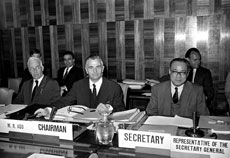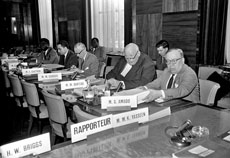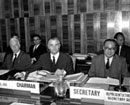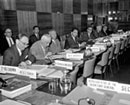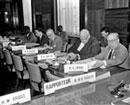|
Convention on Special Missions
New York, 8 December 1969
By Sir Michael Wood
Senior Fellow of the Lauterpacht Centre for International Law University of Cambridge
Introduction
Historical Context
Ad hoc diplomacy is the oldest form of diplomacy. As the United Nations Secretariat explained in 1963: “The custom of sending a special envoy on mission from one State to another, in order to mark the dignity or importance of a particular occasion, is probably the oldest of all means by which diplomatic relations may be conducted. It was only with the emergence of national States on a modern pattern that permanently accredited diplomatic missions, entrusted with a full range of powers, came to take the place of temporary ambassadors sent specially from one sovereign to another. However, although the legal rules which were evolved to determine diplomatic relations between States were therefore based largely on the conduct of permanent missions, so that special missions came to seem merely a particular variant of the other, the sending of special missions was never discontinued. During the eighteenth and nineteenth centuries such missions were frequently dispatched in order to provide suitable State representation at major ceremonial occasions, such as coronations or royal weddings, or for the purposes of important political negotiations, particularly those held at international congresses.” (Yearbook of the International Law Commission 1963, vol. II, p. 151, para. 3) Negotiating History
In submitting its final draft on diplomatic intercourse and immunities to the General Assembly in 1958, the International Law Commission stated that, although the draft dealt only with permanent diplomatic missions, diplomatic relations also assumed other forms that might be placed under the heading of “ad hoc diplomacy”, covering itinerant envoys, diplomatic conferences and special missions sent to a State for limited purposes (Yearbook of the International Law Commission 1958, vol. II, p. 89, para. 51). Also in 1958, the Commission requested A. E. F. Sandström (the Special Rapporteur for the topic “Diplomatic intercourse and immunities”) to submit a report at a future session, and in 1959 appointed him Special Rapporteur for the new topic “Special missions”. In 1960, on the basis of Sandström’s report, but without the usual in-depth study, the Commission adopted and submitted to the General Assembly three draft articles on special missions, together with commentaries, making it clear that the draft should be regarded “as constituting only a preliminary survey”(Yearbook of the International Law Commission 1960, vol. II, p. 179, para. 37). The articles would have applied the rules developed for the privileges and immunities of permanent diplomatic missions to special missions. The General Assembly, by resolution 1504 (XV) of 12 December 1960, decided that the three draft articles should be referred to the United Nations Conference on Diplomatic Intercourse and Immunities (the Vienna Conference) so that they could be considered together with the draft articles on permanent diplomatic missions. At the Vienna Conference, the question of special missions was referred to a Subcommittee established by the Committee of the Whole. While stressing the importance of the subject of special missions, the Subcommittee noted that, because of lack of time, the draft articles on special missions had, in contrast with the usual practice, not been submitted to Governments for their comments before being drafted in final form, and that the draft articles did little more than indicate which of the rules on permanent missions applied, and which did not apply, to special missions. The Subcommittee considered that, while the basic rules might in fact be the same, it could not be assumed that such an approach necessarily covered the whole field of special missions. Following consideration of the topic by the Subcommittee and by the Committee of the Whole, the Vienna Conference adopted a resolution recommending to the General Assembly that it refer the topic back to the International Law Commission (A/CONF.20/10/Add.l). In 1961, the General Assembly adopted resolution 1687 (XVI) of 18 December 1961 requesting the International Law Commission to study further the subject of special missions and to report thereon to the Assembly. In 1963, the Commission appointed Milan Bartoš as Special Rapporteur and decided that he should prepare draft articles, based on the provisions of the Vienna Convention on Diplomatic Relations of 1961 but that he should keep in mind that special missions were, by virtue of both their functions and nature, an institution distinct from permanent missions. The Commission considered this topic between 1964 and 1967. In connection with its work on this topic, the Commission had before it four reports of the Special Rapporteur, information provided by Governments as well as a document prepared by the Secretariat. In 1964, the Commission provisionally adopted sixteen articles, which were submitted to the General Assembly and to Governments for information. At the first part of its session, in 1965, the Commission provisionally adopted twenty-eight further draft articles. All draft articles then adopted were submitted to the General Assembly for its consideration and were also transmitted to Governments for comment. In 1966, the Commission examined certain questions of a general nature affecting special missions which had arisen out of the opinions expressed in the Sixth (Legal) Committee of the General Assembly and the written comments by Governments and which it was important to settle as a preliminary to the later work on the draft articles. In 1967, the Commission adopted a set of 50 final draft articles on special missions, and submitted them to the General Assembly with a recommendation “that appropriate measures be taken for the conclusion of a convention on special missions” (Yearbook of the International Law Commission 1967, vol. II, p. 347, para. 33). The Sixth Committee recommended that an item entitled “Draft convention on special missions” be placed on the provisional agenda of the General Assembly’s 1968 session with a view to the adoption of a convention by the Assembly. By resolution 2273 (XXII) of 1 December 1967, the Assembly adopted the recommendation of the Sixth Committee and invited Member States to submit comments and observations on the draft articles. Over two sessions, in 1968 and 1969, the Sixth Committee considered the item “Draft convention on special missions” on the basis of the Commission’s final draft articles. By resolution 2530 (XXIV) of 8 December 1969, the General Assembly, upon the recommendation of the Sixth Committee, adopted the Convention on Special Missions. Key provisions
Articles 1 to 18 and 20 of the Convention on Special Missions deal with the use of terms, and the sending, structure and functioning of the mission. Articles 9, paragraph 2, 19, and 21 to 49 set out the privileges and immunities of the mission, and articles 50 to 55 the final clauses. The final clauses were standard at the time, though the inclusion of the so-called “Vienna formula” on participation was politically contentious. As is the case with the Vienna Conventions on Diplomatic and Consular Relations, the preamble to the Special Missions Convention acknowledges the functional basis for the privileges and immunities for the privileges and immunities: “Realizing that the purpose of privileges and immunities relating to special missions is not to benefit individuals but to ensure the efficient performance of the functions of special missions as missions representing States”. Article 1(a) of the Convention defines a special mission, for the purposes of the Convention, as follows: “a ‘special mission’ is a temporary mission, representing the State, which is sent by one State to another State with the consent of the latter for the purpose of dealing with it on specific questions or of performing in relation to it a specific task”. This definition contains a number of elements: the temporary character of the mission (which distinguishes it from a permanent diplomatic mission); the fact that it represents the sending State; and the fact that it is sent “for the purposes of dealing with [the receiving State] on specific questions or of performing in relation to it a specific task”. Above all, article 1 makes it clear that a special mission may only be sent with the consent of the receiving State, consent that is to the sending of the special mission as such. Article 2 specifies that consent means prior consent, and that it must be given through the diplomatic or other agreed or mutually acceptable channel. Article 3 makes yet further provision for consent, by providing that – “The functions of a special mission shall be determined by the mutual consent of the sending and the receiving State.” The Convention contains no other provision defining the functions of special missions: there is no provision corresponding to article 3 of the Vienna Convention on Diplomatic Relations or article 5 of the Vienna Convention on Consular Relations. It was suggested during the negotiations that “[t]he normal task which a special mission will perform is a task that would ordinarily be performed by a permanent diplomatic mission of the sending State” (A/C.6/SR.1129, paras. 25-26). Permanent diplomatic missions have a wide range of functions, and are by no means limited to what may be thought of as classical diplomacy. In any event, there was no agreement during the negotiations to limit the functions that might be performed by a special mission. Some States considered that special missions might concern technical matters as well as political ones. The key lies in the requirement of mutual consent on the functions of the mission. Two or more States may each send a special mission at the same time to another State in order to deal together with questions of common interest (article 6). Again, the emphasis is on consent. Article 18 provides that special missions from two or more States may meet in the territory of a third State, but only after obtaining the express consent of that State. Provision is made for the various categories of members of special missions (article 1). The sending State may freely appoint the members of the special mission, but their details must be given to the receiving State prior to their appointment, and that State may object to the overall size of the mission or to individual persons (article 10). Detailed provision is made for notifications to the Ministry of Foreign Affairs of the receiving State (article 11). All official business is to be conducted with or through the Ministry of Foreign Affairs of the receiving State or with such other organ of the receiving State as may be agreed (article 15). The scale of facilities, privileges and immunities provided for in the Convention (articles 22 to 49) follows, with only relatively minor modifications, that provided in relation to permanent diplomatic missions by the Vienna Convention on Diplomatic Relations. This includes, most importantly, inviolability of the person and immunity from criminal jurisdiction of members of special missions (articles 29 and 31, paragraph1). It also includes immunity from civil and administrative jurisdiction, subject to the same exceptions as members of a permanent diplomatic mission plus an additional exception for “an action for damages arising out of an accident caused by a vehicle used outside the official functions of the person concerned” (article 31, paragraph 2). Among the other differences between the privileges and immunities accorded under the Convention on Special Missions and the Vienna Convention on Diplomatic Relations are the following: tax exemption for the premises of the special mission applies only “[t]o the extent compatible with the nature and duration of the functions performed by the special mission” (article 24); the head of mission’s consent to enter the premises of the mission may be presumed “in case of fire or other disaster that seriously endangers public safety”, and it has not been possible to obtain his or her express consent (article 25); and archives and documents “should, when necessary, bear visible external marks of identification” (article 26). Article 21 provides that the Head of the sending State, when he or she leads a special mission, enjoys the facilities, privileges and immunities accorded by international law to Heads of State on an official visit; and further that the Head of Government, Minister for Foreign Affairs and “other persons of high rank”, when they take part in a special mission, enjoy, in addition to what is granted by the Convention, the facilities, privileges and immunities accorded by international law. The Optional Protocol concerning the Compulsory Settlement of Disputes is modelled on the corresponding Optional Protocols to the Vienna Conventions on Diplomatic and Consular Relations. It also entered into force on 21 June 1985. At the time of writing (April 2019), there are 17 States parties. Influence of the Convention on Special Missions
The Convention on Special Missions is the applicable international law as between the parties thereto. Yet it is not clear how it is applied in practice even between the parties. In any event, the parties are relatively few, and there are few other treaties on the subject. So, as between most States, and in most circumstances, the governing rules on special missions and other official visitors are to be found in customary international law. It is difficult not to share Sinclair’s assessment: “[t]his effort at progressive development and codification has accordingly been only partially successful, no doubt because of the reluctance of Governments to accord a wide range of privileges and immunities to special missions and their members when, in the view of the Governments concerned, the grant of such privileges and immunities was not justified by functional reasons.” (I. Sinclair, The International Law Commission (1987), p. 61) While the elaboration of the Convention within the International Law Commission and in the Sixth Committee of the General Assembly has no doubt influenced the rules of customary international law in the field, there is no reason to suppose that all or even most of its provisions are reflected in customary law, given the circumstances of its adoption and the lack of support for the Convention among States. Although some uncertainties remain as to the precise scope of special mission immunities under customary international law, it is generally accepted that customary international law requires mutual consent and representation of the sending state, and the grant of personal inviolability and immunity from criminal jurisdiction for the duration of the special mission and during a reasonable period of time for travel. But it would seem that the rules of customary international law are both wider and narrower than the provisions of the Special Missions Convention. They are wider in that the class of official visitors who may be entitled to immunity is wider than that foreseen in the Convention.They are narrower in that the range of privileges and immunities is more limited, being essentially confined to immunity from criminal jurisdiction and inviolability of the person. This Introductory Note was written in August 2012.
Related Materials
The Commission decided at its eleventh session, in 1959, to place the question of ad hoc diplomacy as a special topic on the agenda for its twelfth session, and appointed Mr. Sandström as Special Rapporteur for the topic (A/4169, pp. 122-123). The Special Rapporteur presented his report on “Ad hoc diplomacy” to the Commission in anticipation of its twelfth session in 1960 (A/CN.4/129). On the basis of this report, at its twelfth session, the Commission adopted three draft articles on “special missions” together with commentaries. In the report covering the work of its twelfth session, the Commission stated that the draft should be regarded ‘‘as constituting only a preliminary survey”; the Commission, nevertheless, recommended that the General Assembly should refer the draft to the United Nations Conference on Diplomatic Intercourse and Immunities which was to meet in Vienna in the spring of 1961 (“Vienna Conference”). At the same session, the Commission, observing that the question of “diplomatic conferences” was linked not only to that of “special missions” but also to that of “relations between States and international organizations”, decided not to deal with the subject of “diplomatic conferences” for the moment (A/4425). The General Assembly, by resolution 1504 (XV) of 12 December 1960, decided that the draft articles on special missions should be referred to the Vienna Conference so that they could be considered together with the draft articles on permanent diplomatic missions. At the Vienna Conference, the question of special missions was referred to a Subcommittee established by the Committee of the Whole. Following consideration of the topic by the Subcommittee and by the Committee of the Whole, the Vienna Conference adopted a resolution recommending to the General Assembly that it refer the topic back to the International Law Commission (A/CONF.20/10/Add.l). At its sixteenth session, the General Assembly adopted resolution 1687 (XVI) of 18 December 1961, requesting the Commission to study further the subject of special missions and to report thereon to the Assembly. In pursuance of this resolution, the Commission decided at its fourteenth session, in 1962, to include the topic of special missions on its agenda for the following session (A/5209, p. 192); the Commission also indicated that the Secretariat would prepare a working paper on this topic (A/CN.4/155). During its fifteenth session, in 1963, the Commission appointed Milan Bartoš as Special Rapporteur for the topic of special missions and decided that he should prepare draft articles, based on the provisions of the 1961 Vienna Convention on Diplomatic Relations but that he should keep in mind that special missions were, by virtue of both their functions and nature, an institution distinct from permanent missions. With regard to the scope of the topic, most of the members of the Commission expressed the opinion that for the time being the question of status of government delegates to international conferences should not be covered in the study on special missions. In addition, the Commission stated that the time was not yet ripe for deciding whether the draft articles on special missions should be in the form of an additional protocol to the Vienna Convention, 1961, or should be embodied in a separate convention or in any other appropriate form, and that the Commission would await the Special Rapporteur’s recommendations on that subject (A/5509, p. 225). At its eighteenth session, in 1963, after discussion in the Sixth Committee of the General Assembly (A/C.6/SR.780-793), the General Assembly recommended in resolution 1902 (XVIII) of 18 November 1963 that the Commission continue its work on special missions, taking into account the views expressed in the General Assembly. At its sixteenth session, in 1964, the Commission considered the first report of the Special Rapporteur (A/CN.4/166) and provisionally adopted sixteen articles, which were subsequently submitted to the General Assembly and to Governments for information (A/5809). The General Assembly did not discuss the report of the Commission at its nineteenth session in 1964, and consequently did not express its opinion on the draft articles. At the first part of its seventeenth session, in 1965, the Commission considered the second report of the Special Rapporteur (A/CN.4/179) and provisionally adopted twenty-eight articles, which followed on from the sixteen articles previously adopted. All draft articles adopted at the sixteenth and seventeenth sessions were submitted to the General Assembly for its consideration and were also transmitted to Governments for comment (A/6009, pp. 163-191). At the twentieth session of the General Assembly, in 1965, the draft articles and general topic of special missions were discussed in the Sixth Committee of the General Assembly (A/C.6/SR.839-853). The General Assembly adopted resolution 2045 (XX) on 8 December 1965, and recommended that the Commission, taking into account the views expressed during the twentieth session and the comments submitted by Governments, present final drafts on this topic in the report of the Commission’s work at its eighteenth session. At its eighteenth session, in 1966, the Commission had before it the third report of the Special Rapporteur (A/CN.4/189 and Add.1 & 2) and comments received by Governments on the draft articles (A/CN.4/188 and Add. 1-3). The Commission examined certain questions of a general nature affecting special missions which had arisen out of the opinions expressed in the Sixth Committee of the General Assembly and the written comments by Governments, and which it was important to settle as a preliminary to the later work on the draft articles (the nature of the provisions relating to special missions; distinction between the different kinds of special missions; the question of introducing into the draft articles a provision prohibiting discrimination; reciprocity in the application of the draft; relationship with other international agreements; form of the instrument relating to special missions; adoption of the instrument relating to special missions; preamble; arrangement of the articles; draft provisions concerning so-called high-level special missions; introductory article). As the Commission did not have time to consider the comments of Governments on the draft articles on special missions, and as a limited number of Governments had communicated their comments, the Commission decided to request Members States to forward their comments on the subject as soon as possible and, in any case, before 1 March 1967 (A/6309/Rev.1, pp. 274-277). At the twenty-first session of the General Assembly, after a debate in the Sixth Committee (A/C.6/SR.902-919), the General Assembly adopted resolution 2167 (XXI) of 5 December 1966, in which it recommended that the Commission continue its work relating to special missions with the object of presenting a final draft on the topic in its next report. At its nineteenth session, in 1967, the Commission examined the Special Rapporteur’s fourth report (A/CN.4/194) and took into account the written comments received from Governments (A/CN.4/188 and Add.1-4) and the views expressed in the Sixth Committee. The Commission adopted its final draft on special missions, comprising fifty draft articles, with commentaries, and submitted them to the General Assembly with a recommendation “that appropriate measures be taken for the conclusion of a convention on special missions” (A/6709/Rev.1 and Corr.1, p. 347). At the twenty-second session of the General Assembly, in 1967, after discussion (A/C.6/SR.957-968, 970-974), the Sixth Committee recommended that an item entitled “Draft convention on special missions” be placed on the provisional agenda of the General Assembly’s twenty-third session with a view to the adoption of such a convention by the Assembly (A/6898). By resolution 2273 (XXII) of 1 December 1967, the Assembly adopted the recommendation of the Sixth Committee and invited Member States to submit comments and observations on the draft articles. At the General Assembly’s twenty-third and twenty-fourth sessions, in 1968 and 1969, respectively, the Sixth Committee considered the item “Draft convention on special missions” on the basis of the draft adopted by the Commission. At each session, Switzerland was invited to participate in the relevant proceedings of the Sixth Committee as an observer without the right to vote. At the twenty-third session, the Sixth Committee had before it the draft articles adopted by the Commission in 1967; it also had before it comments submitted by Governments on the draft text and amendments to individual articles put forward by various delegations (A/6709/Rev.1 and Corr.1). After having decided to leave aside, at that stage, article 1 (on the use of terms), the Sixth Committee examined and adopted 29 of the 50 articles in two stages. In the first stage, it considered articles 2 to 29 and article 31, and referred them all to a drafting committee in their original or in an amended form. In the second stage, it considered the texts recommended by the Drafting Committee and adopted them, generally without change (A/7375). The General Assembly, by resolution 2419 (XXIII) of 18 December 968, placed the examination of the draft convention upon the agenda of its twenty-fourth session. At the twenty-fourth session, in 1969, the Sixth Committee considered the twenty draft articles which it had not been able to discuss at its previous session and on new amendments proposed by the United Kingdom (A/C.6/L.745 and Corr. 1) and by Switzerland (A/C.6/L.766). It also adopted a draft preamble (A/C.6/L.751/Add.6) and a set of final clauses for the Convention (A/C.6/L.751/Add.5). On the proposal of Bolivia, Brazil, India, Iraq, Trinidad and Tobago and Tunisia (A/C.6/L.764 and Add.1 and 2), the Sixth Committee decided, on 29 October 1969, to replace article 42 of the Commission’s draft, concerning the settlement of civil claims, by a draft resolution on the settlement of civil claims which the Committee later adopted and recommended for adoption by the General Assembly. On 8 December 1969, the General Assembly adopted resolution 2531 (XXIV) (Settlement of civil claims in connexion with the Convention on Special Missions). Also during the twenty-fourth session, Switzerland proposed a new amendment on the settlement of disputes, which would have provided that disputes arising out of the interpretation or application of the Convention were to lie within the compulsory jurisdiction of the International Court of Justice (A/C.6/L.766). While this proposal was rejected by the Sixth Committee, a sub-amendment submitted by 12 states to incorporate the substance of the Swiss proposal in a draft optional protocol was adopted by the Sixth Committee on 10 November 1969 (A/C.6/L.769 and Add. 1). After coordination and review by the Drafting Committee, the final text of the draft Optional Protocol was adopted by the Sixth Committee on 4 December 1969 (A/C.6/L.779/Add.5). The Sixth Committee also had before it three drafts of final clauses submitted to the Drafting Committee by France, the United Kingdom and the United States; by the Union of Soviet Socialist Republics; and by Ghana and India, respectively. The Sixth Committee adopted the first of these proposals on 17 November 1969 (A/C.6/L.773, annex, part II), which would become articles 50 to 55 of the Convention. By resolution 2530 (XXIV) of 8 December 1969, the General Assembly, upon the recommendation of the Sixth Committee, adopted the Convention on Special Missions and the Optional Protocol concerning the Compulsory Settlement of Disputes relating thereto. The final provisions of the Convention open it for signature and for ratification or accession by all States Members of the United Nations or members of any of the specialized agencies or of the International Atomic Energy Agency or parties to the Statute of the International Court of Justice, and also by any other State invited by the General Assembly to become a party to the Convention. The final provisions of the Optional Protocol open it for signature and for ratification or accession by all States which may become parties to the Convention. The Convention and the Optional Protocol came into force on 21 June 1985. Text of the Convention Selected preparatory documents International Law Commission, Summary records of meeting no, 6, held on 20 April 1949 (A/CN.4/SR.6, reproduced in Yearbook of the International Law Commission 1949, vol. I, p. 49). The Convention entered into forcce on 21 June 1985. For the current participation status of the Convention, as well as information and relevant texts of related treaty actions, such as reservations, declarations, objections, denunciations and notifications, see: The Status of Multilateral Treaties Deposited with the Secretary-General |

